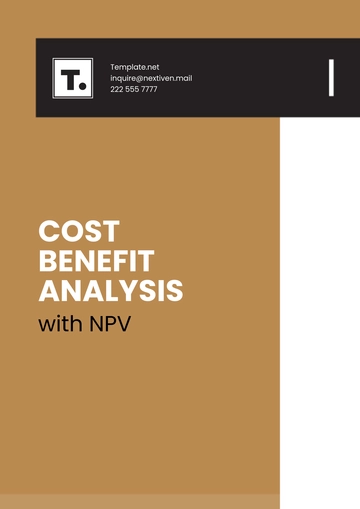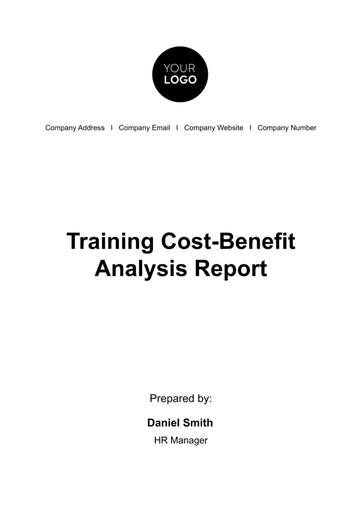Free Car Rental Value Analysis

I. Introduction
A. Purpose of the Value Analysis
The Car Rental Value Analysis aims to evaluate the financial health and operational efficiency of [Your Company Name]'s car rental division over the past fiscal year. By analyzing key performance indicators such as revenue streams, cost structures, and profitability metrics, this analysis seeks to identify opportunities for enhancing revenue generation, optimizing operational processes, and improving overall business performance.
B. Scope and Objectives
This analysis covers the period from [Start Date] to [End Date], encompassing all revenue-generating activities and operational expenses related to the car rental division. Specific objectives include assessing the effectiveness of pricing strategies, evaluating the impact of additional service offerings on revenue, and providing strategic recommendations to align with market trends and customer expectations.
II. Company Overview
A. Background and History
Established in [Year], [Your Company Name] has grown to become a leading provider of car rental services in [City]. With a fleet comprising over [000] vehicles ranging from economy to luxury models, the company prides itself on a commitment to customer satisfaction and operational excellence. Over the years, strategic expansions and investments in technology have strengthened its market position and enhanced service delivery.
B. Organizational Structure
[Your Company Name]'s car rental division operates within a matrix organizational structure, integrating functions such as fleet management, customer service, marketing, and finance. This structure ensures seamless coordination and efficient decision-making across departments, supported by regular performance reviews and strategic planning sessions at the executive level. Key decision-makers include the CEO, CFO, and divisional heads, who oversee operations and ensure alignment with corporate objectives.
C. Market Position and Competitive Landscape
In the competitive landscape of the local car rental industry, [Your Company Name] maintains a strong market presence characterized by a diverse customer base and strategic alliances with travel agencies and corporate clients. Competitive advantages include a robust loyalty program, competitive pricing strategies, and a reputation for reliability and customer service excellence. However, challenges such as price sensitivity and fluctuating demand patterns necessitate continuous adaptation to market dynamics.
III. Financial Performance Analysis
A. Revenue Analysis
Rental Fees
Vehicle Category | Average Daily Rate ($) | Total Revenue Contribution (%) |
|---|---|---|
Economy | $[0] | [0]% |
Mid-size | ||
SUV | ||
Luxury |
Rental fees differ depending on the category of vehicle, where economy models, despite having the highest volume of rentals, are available at lower rates compared to luxury and SUV models. Upon analyzing the data, it is evident that the average daily rate across all vehicle categories is $[0]. This pricing structure significantly contributes to the total annual revenue, which amounts to $[0] million.
Additional Services
Service Offering | Annual Revenue ($) | Contribution to Total Revenue (%) |
|---|---|---|
Insurance Packages | $[0] | [0]% |
GPS Rentals | ||
Roadside Assistance |
Additional services, which include offerings like insurance packages and GPS rentals, play a crucial role in enhancing the company’s revenue. These supplementary services are responsible for generating approximately [0]% of the total annual income.
The company has employed effective strategies for bundling these services together and has mastered the art of upselling, thereby significantly boosting the adoption rates of these additional services among their customers. The success of these tactics is evident in the sizable contribution these services make to the overall financial performance of the business.
Ancillary Income
Ancillary Service | Annual Revenue ($) | Contribution to Total Revenue (%) |
|---|---|---|
Late Fees | $[0] | [0]% |
Vehicle Upgrades | ||
Additional Mileage |
Income derived from ancillary services, which encompass a variety of charges such as late fees, vehicle upgrades, and additional mileage charges, represents approximately [0]% of the company's total revenue. This strategy of revenue diversification, by incorporating a range of complementary services, not only bolsters the company's overall profitability but also significantly enhances customer satisfaction.
This multifaceted approach to revenue generation ensures that the company can maintain a robust financial performance while simultaneously meeting and exceeding customer expectations through the provision of an array of helpful and convenient services.
B. Cost Analysis
Vehicle Acquisition Costs
Expense Category | Annual Expenditure ($) |
|---|---|
New Vehicle Purchases | $[0] |
Lease Agreements | |
Fleet Expansion Projects |
The yearly financial outlays dedicated to the procurement of new vehicles and the costs associated with leasing arrangements amount to a total of $[0] million. These well-considered and targeted investments are intentionally directed toward the modernization of our vehicle fleet, ensuring that we can continue to evolve and adapt in line with the changing preferences and needs of our customer base.
Maintenance and Repairs
Expense Category | Annual Expenditure ($) |
|---|---|
Routine Maintenance | $[0] |
Major Repairs | |
Parts and Labor Costs |
The operational costs associated with maintaining and repairing the fleet of vehicles amount to an average of $[0] million each year. This figure underscores the emphasis on implementing proactive maintenance schedules, which are designed to minimize any potential downtime and ensure the continued reliability and optimal performance of the fleet.
Fuel and Operating Costs
Expense Category | Annual Expenditure ($) |
|---|---|
Fuel Purchases | $[0] |
Fuel Efficiency Programs | |
Other Operating Costs |
Fuel expenses constitute a significant portion of the total operational costs, amounting to $[0] million. These costs are managed through the implementation of various fuel efficiency programs, in addition to strategic partnerships with fuel providers. These measures are designed to mitigate the impact of cost fluctuations in the fuel market, ensuring a more stable and controlled expenditure on fuel over time.
Insurance Costs
Insurance Type | Annual Expenditure ($) |
|---|---|
Fleet Insurance | $[0] |
Liability Coverage | |
Damage Waivers |
The amount spent annually on insurance premiums for both fleet coverage and liability protection is a total of $[0] million. These premiums have been carefully negotiated to minimize the exposure to potential risks, all the while ensuring full compliance with existing regulatory requirements.
C. Profitability Metrics
Gross Profit Margin
The gross profit margin for the car rental division is currently at X percent, a result that has been achieved through the implementation of highly effective revenue management strategies combined with rigorous cost control measures applied throughout the division's operations.
Net Profit Margin
Following a thorough and comprehensive accounting of all incurred expenses, the resulting net profit margin stands at [0]%. This figure serves to underscore the operational efficiency and sustainable profitability that the company has achieved, particularly within the highly competitive car rental market.
Return on Investment (ROI)
The return on investment (ROI) for vehicle investments averages at [0]%. This figure underscores a wise approach to capital allocation and demonstrates the efficient use of assets. By maximizing returns in this manner, the strategy not only yields immediate financial benefits but also bolsters future growth initiatives, ensuring that resources are aptly utilized and positioned for continued expansion.
IV. Operational Efficiency
A. Vehicle Utilization Rates
Peak vs. Off-Peak Periods
During peak seasons such as summer and holidays, vehicle utilization rates reach as high as [0]%, reflecting robust demand and optimized fleet management strategies. Off-peak periods see utilization rates around [0]%, prompting initiatives to promote weekend and weekday specials to stimulate demand during slower periods.
Average Rental Duration
The average rental duration is approximately [0] days, influenced by customer preferences for short-term rentals among tourists and longer-term rentals for corporate clients. Analysis of rental patterns guides inventory management to align with seasonal variations and maximize revenue potential.
B. Fleet Management
Fleet Size and Composition
[Your Company Name] manages a fleet of [00] vehicles, strategically balanced across economy, mid-size, SUV, and luxury segments to cater to diverse customer preferences. Regular fleet audits and lifecycle management practices ensure optimal composition and minimize depreciation costs.
Age and Depreciation Analysis
The average vehicle age is [0] years, with depreciation costs factored into financial projections and replacement schedules aligned to maintain fleet reliability and customer satisfaction. Investments in newer models and eco-friendly vehicles reflect ongoing commitment to sustainability and customer demand for fuel-efficient options.
C. Rental Process Efficiency
Booking Systems and Reservation Management
Integration of advanced booking systems and online platforms facilitates seamless reservations, reducing processing times and enhancing customer convenience. Real-time inventory updates and predictive analytics streamline allocation of vehicles based on customer preferences and availability.
Check-in and Check-out Processes
Streamlined check-in/out processes leverage mobile check-in options and self-service kiosks, minimizing wait times and improving operational efficiency during peak periods. Customer feedback mechanisms and service recovery protocols ensure consistent service delivery and high satisfaction levels.
V. Customer Analysis
A. Customer Segmentation
Customer segmentation analysis aims to identify distinct groups of customers with specific needs and preferences. According to this analysis, there are three primary categories of customers: The first group comprises leisure travelers. These are individuals who prioritize affordability and convenience when choosing their travel options. They are typically looking for cost-effective solutions and ease of use, often favoring companies that offer straightforward booking processes and competitive pricing. The second group, corporate clients, are business professionals who prioritize reliability and a variety of fleet options over cost. They value service quality and features like premium vehicles and corporate accounts.The third group, local residents, seek flexible rental terms and value-added services for temporary or special occasion needs. They look for options that include varying rental durations and perks like loyalty programs and personalized services. Companies should tailor marketing strategies: focus on affordability and convenience for leisure travelers, highlight reliability and diverse fleet options for corporate clients, and offer flexible terms and supportive services for local residents. This targeted approach boosts customer satisfaction.
B. Customer Acquisition Cost (CAC)
The CAC for acquiring new customers averages $[0], driven by digital marketing campaigns, partnerships with travel agencies, and referral programs. Cost-efficiency metrics evaluate the effectiveness of customer acquisition channels to optimize marketing spend and enhance ROI.
C. Customer Lifetime Value (CLV)
Calculations indicate a CLV of $[0], reflecting customer retention rates and repeat business generated through personalized service offerings and loyalty incentives. Strategic initiatives focus on enhancing CLV through continuous engagement, proactive customer support, and value-added services.
D. Customer Satisfaction and Feedback
Customer satisfaction scores consistently exceed industry benchmarks, with an average rating of [0]%. Regular feedback surveys and service audits inform continuous improvement initiatives, ensuring responsiveness to customer preferences and maintaining high service standards.
VI. Market Analysis
A. Industry Trends and Forecasts
Emerging trends in urban mobility and sustainability influence market dynamics, prompting [Your Company Name] to explore opportunities in electric vehicle rentals and eco-friendly initiatives. Market forecasts project steady growth in car sharing and on-demand rental services, signaling future investment potential.
B. Competitive Analysis
Pricing Strategies
Competitive pricing analysis reveals [Your Company Name]'s positioning relative to competitors, emphasizing value-based pricing models and promotional discounts during peak seasons. Dynamic pricing algorithms adjust rates based on demand fluctuations and competitor actions to maximize revenue yield.
Service Offerings Comparison
Benchmarking against industry peers highlights strengths in customer service quality, fleet diversity, and technological integration. Strategic differentiation through premium services and enhanced customer experiences reinforces [Your Company Name]'s competitive advantage in the local market.
C. SWOT Analysis
Strengths: Strong brand equity, extensive network, and customer loyalty programs.
Weaknesses: Vulnerability to economic downturns, high dependency on seasonal demand fluctuations.
Opportunities: Expansion into adjacent markets, integration of smart technology solutions.
Threats: Competitive pricing pressures, regulatory changes impacting operational costs.
VII. Strategic Recommendations
A. Opportunities for Revenue Growth
Consider the opportunity to establish collaborative relationships with ride-sharing platforms in an effort to develop and offer integrated mobility solutions. By doing so, you can effectively tap into the increasing consumer demand for seamless travel experiences, wherein customers are seeking convenient, end-to-end transportation options that simplify their journeys and enhance their overall travel satisfaction.
B. Cost Reduction Strategies
To enhance the operational efficiency and reduce the expenses associated with repairs of a fleet, it is essential to implement advanced predictive maintenance technologies. By doing so, one can optimize the amount of time that vehicles remain functional and available for use. These sophisticated technologies utilize data-driven insights to forecast potential maintenance requirements.
As a result, they enable the preemptive identification and resolution of maintenance issues before they escalate into more significant problems. This proactive approach ensures that vehicle maintenance needs are addressed in a timely manner, ultimately contributing to both the extended uptime of the fleet and the reduction of overall repair costs.
C. Improvements in Customer Experience
Develop and introduce a new mobile application aimed at providing personalized interactions with customers, including tailored loyalty rewards. This initiative will significantly enhance customer engagement and retention by offering a seamless and convenient platform for booking services and accessing various features and benefits.
D. Expansion or Diversification Opportunities
Conduct an in-depth assessment to determine the practicality and potential benefits of expanding our business operations to include long-term leasing options specifically designed for corporate clients. Additionally, explore the opportunities for entering into new markets located in adjacent regions. This strategic move aims to diversify our sources of revenue and reduce the impact of seasonal fluctuations on our financial performance.
VIII. Conclusion
A. Summary of Findings
The Car Rental Value Analysis underscores [Your Company Name]'s robust financial performance, driven by strategic revenue diversification and effective cost management initiatives. Key findings reveal strong revenue contributions from rental fees and ancillary services, complemented by a competitive cost structure that supports sustainable profitability. Operational efficiencies, including high vehicle utilization rates during peak periods and streamlined rental processes, further enhance overall performance metrics.
B. Key Takeaways
Operational Efficiency: Optimized fleet management practices and proactive maintenance schedules have minimized downtime and operational costs.
Customer Satisfaction: High customer satisfaction ratings validate [Your Company Name]'s commitment to service excellence and personalized customer experiences.
Market Positioning: Strategic pricing strategies and service differentiation strategies position [Your Company Name] favorably amidst competitive pressures.
C. Future Outlook and Strategic Direction
Looking ahead, [Your Company Name] is poised to capitalize on emerging trends in urban mobility and sustainable transport solutions. Strategic initiatives will focus on:
Technology Integration: Enhancing digital platforms and mobile applications to streamline booking processes and improve customer engagement.
Expansion Opportunities: Exploring new geographic markets and innovative service models such as electric vehicle rentals to broaden market reach and diversify revenue streams.
Operational Excellence: Continuously refining operational efficiencies and cost-saving measures to maintain competitiveness and profitability in a dynamic market landscape.
By leveraging strengths in brand equity, customer loyalty, and operational excellence, [Your Company Name] is well-positioned to sustain growth and adapt to evolving market demands.
- 100% Customizable, free editor
- Access 1 Million+ Templates, photo’s & graphics
- Download or share as a template
- Click and replace photos, graphics, text, backgrounds
- Resize, crop, AI write & more
- Access advanced editor
Discover the ultimate Car Rental Value Analysis Template on Template.net. This editable and customizable template, crafted with precision, includes detailed sections for financial performance, operational efficiency, customer insights, and strategic recommendations. Streamline your analysis effortlessly with intuitive features and an AI Editor Tool, ensuring your car rental business thrives with informed decisions.





























